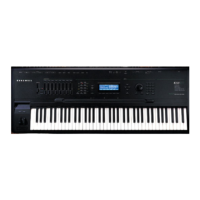Setup Mode
The ARPEGGIATOR & ARPEGGIATOR 2 (ARP1, ARP2) Pages
7-51
AutoisindependentofLatch;everynoteyouplayisautomaticallylatched,andtheArpeggiator
runsaslongasyouholdatleastonearpeggiatednote.Aslongasyoukeepholdingonatleast
onenote(itdoesn’thavetobethesamenotethewholetime),everynoteyou
playinthe
arpeggiationrangegetslatched.
PedalsissortofacombinationofKeys,Add,andOverplaymodes.ItreliesonbothLatch(MIDI
157)andLatch2(MIDI158).Ifneitherlatchcontrollerison,noteswillarpeggiateonlywhileyou
areholdingdownkeys(similartoKeysmode).If
youactivateController158,thekeyscurrently
helddownwilllatch,andanyadditionalkeysplayedwhileController158isonwillalsolatch
(similartoAddmode).WhenController158isoff,anykeysthatarenotcurrentlyhelddown
willberemovedfromthearpeggiation.Ifyouactivate
Controller157,keyscurrentlyhelddown
willlatch,andanyadditionalkeysplayedwhileController157isonwillplaynormally(similar
toOverplaymode).ThismodeiscalledPedalsmodebecauseyoumightwanttoassign
Footswitch1toLatch(Controller157)andFootswitch2toLatch2(Controller158)to
makethe
pedalsfunctionsimilarlytosustainandsostenutopedals.Additionally,youcould assignone
FootswitchtoSusLatch(Controller160)—doingthismakestheFootswitchactasasustainpedal
whenArpisoff,andasaLatchpedalwhenArpison.
AutoholdissimilartoAuto.Holdingatleastone
arpeggiatednoteonandplayingothernotes
latchesthosenotes.UnlikeinAutomode,ifyoustopholdingatleastonearpeggiatednoteon,
thearpeggiationcontinuesplaying(althoughyoucan’tlatchanymorenotes).Inthiscase,ifyou
strikeanotherkeywithinthesetup’s arpeggiationrange,youstart
anewarpeggiationsequence.
Autoholdisusefulforarpeggiatingchords:whenyouplayachord,itgetslatched,and
continuesarpeggiatingafteryoureleasethechord.Whenyouplayanotherchord,theprevious
chordgetsunlatched,andthenewonegetslatched.YoucanusethePanicsoftbuttontostop
arpeggiationatanytime.
1NoteAutoissimilartoAutohold,exceptonlythelastnoteplayedislatched(evenifpreviously
playednotesarestillbeingheld.)1NoteAutoiss p ecificallydesignedforusewithShiftPatterns
(seeabove,)becauseShiftPatternsaredesignedtobeplayedfromonenoteatati me
(though
youcanuse1NoteAutowithoutaShiftPatternaswell.)Using1NoteAutoforzonesthatusea
ShiftPatternensuresthatShiftPatternswillsoundcorrectbyonlyallowingonenoteatatimeto
triggerthepattern.YoucanusethePanicsoftbuttontostoparpeggiationat
anytime.
1NoteAutoLowand1NoteAutoHiarealsodesignedforusewithShiftPatterns.Theywork
similarlyto1NoteAuto,except1NoteAutoLowalwayslatchesthe lowestnotewhenholding
multiplenotes,and1NoteAutoHialwayslatchesthehighestnotewhenholdingmultiplenotes.
YoucanalsousetheselatchtypeswithoutaShiftPattern
ifdesired.
Low Key (LoKey) and High Key (HiKey)
TheArpeggiatorprocessesnoteswithintherangeoftheseparameters.Notesoutsidethe
specifiedrangeplaynormally,anddonotbecomepartofthearpeggiationsequence.Setthe
LoKeyandHiKeyparametersusingthedataentrywheelorbuttons.
Glissando
WhentheGlissandoparameterisOn,theArpeggiatorchromatically
fillsbetweenlatchednotes.
WhenGlissandoison,theArpeggiatorignorestheNoteShift,ShiftLimit,andLimitOption
parameters.
Youmustlatchatleasttwonotestogetaresult. WhenGlissandoison,allnotesplayedinthe
arpeggiationrangegetlatched,althoughyouwon’tnecessarilygetmeaningfulresults
fromall
latchednotes.Ingeneral,trytogeteachsubsequentnoteyoulatchtobeachangeindirection.
Forexample,trylatchingthefollowing sequenceofnotes:C4, C5,G4,G5,C5,C6,G4,G5.The
“glissando”changesdirectionaroundeachchangeindirectionofthelatchednotes.

